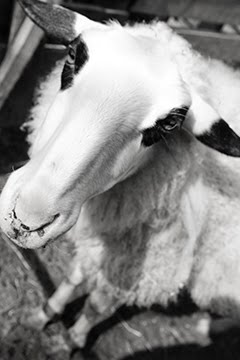Now that we've had a small break from duck,
we are going to go all out with everything duck right now.
(*This post is definitely not for the vegetarians/vegans out there.)
we are going to go all out with everything duck right now.
(*This post is definitely not for the vegetarians/vegans out there.)
First up is duck pâte- so we needed to bring out the handy meat grinder...
 Slowly but surely the duck meat was fed through the top of the grinder,
Slowly but surely the duck meat was fed through the top of the grinder,and came out nice and...ground..? onto the dish.
 Note the deep yellow color of the farm-fresh egg yolks-- incredible.
Note the deep yellow color of the farm-fresh egg yolks-- incredible.The egg gets mixed right in with the meat, and then it's
molded into little bowls and decorated with a bay leaf & a few peppercorns.
 Pop it in the oven, spread it on a baguette and voila! Delicieux
Pop it in the oven, spread it on a baguette and voila! DelicieuxNext up is Civet, which is a very, very close cousin to
Boeuf Bourguignon, if not a fraternal twin even.
Don't like duck? You can substitute really any game or red poultry in this dish.
 Brown the meat, carrots, leeks, shallots, celery and bacon ends. In a separate pot, boil 2 1/2 bottles of red wine and add the bouquet garni(thyme & parsley). Add everything back into the browning pot, pouring in the wine, some peppercorn and 4 bay leaves.Boil, then let simmer
Brown the meat, carrots, leeks, shallots, celery and bacon ends. In a separate pot, boil 2 1/2 bottles of red wine and add the bouquet garni(thyme & parsley). Add everything back into the browning pot, pouring in the wine, some peppercorn and 4 bay leaves.Boil, then let simmerfor 2 hours(it's better/more flavorful the next day, so be patient and reheat it later!)
 Civet, served with delicious buttery polenta. Mmmmmmm
Civet, served with delicious buttery polenta. Mmmmmmm
Moving on to Rillettes, a true duck phenomenon and relatively simple.
Muscovy is the duck of choice for this dish, as they are extra meaty.
Muscovy is the duck of choice for this dish, as they are extra meaty.
 Put the wings, carcass, neck and breast(opt) in a pot with bay leaves, peppercorn, onion, carrots, leeks, celery leaves, and fresh thyme. Add water 1/2 up the pot, boil, simmer for about 2 hours, until meet is very tender. This creates really flavorful juices that will be put back into the recipe.
Put the wings, carcass, neck and breast(opt) in a pot with bay leaves, peppercorn, onion, carrots, leeks, celery leaves, and fresh thyme. Add water 1/2 up the pot, boil, simmer for about 2 hours, until meet is very tender. This creates really flavorful juices that will be put back into the recipe. This is the fun part if you like to get your hands dirty. Take all the meat off the bone, discard the meet and ligament. MASH MASH MASH the meat with your hands until it turns into a nice paste. Add: 1 c broth from pot, 1 c duck fat, 1 tsp pepper, and 1 Tbl large salt crystals.
This is the fun part if you like to get your hands dirty. Take all the meat off the bone, discard the meet and ligament. MASH MASH MASH the meat with your hands until it turns into a nice paste. Add: 1 c broth from pot, 1 c duck fat, 1 tsp pepper, and 1 Tbl large salt crystals. Now, you can put this in a terrine/wok and eat relatively soon,
Now, you can put this in a terrine/wok and eat relatively soon,or you can sterilize it in jars and keep it for up to 1 year.
We chose to sterilize them, but let me tell you, they will not last for a year in this house.
Almost there! The 4th recipe is none other than Confit de Canard.
 Take all the duck parts and rub with salt. Let it stand in the frig for about 24 hours.
Take all the duck parts and rub with salt. Let it stand in the frig for about 24 hours.To get the duck fat- cut out all the fat you can find and melt it in a skillet. Strain it to make sure there are no chunks. Retrieve the duck parts, wash off the salt with cold water,
pat dry, and let then simmer in the fat for 2 hours.
Fit them into jars and pour the fat over and around the parts to be 'confited', and seal them well.
 Now, Confit means to preserve, like confiture(jam). You can confit just about anything that produces fat, like pork. So while we made the Confit de Canard today,
Now, Confit means to preserve, like confiture(jam). You can confit just about anything that produces fat, like pork. So while we made the Confit de Canard today,we should really let it sit on the shelf for 2 months or so before eating it.
Most likely, when you order Confit de Canard at a restaurant it is not the true/preserved dish.
Next? Last? Getting tired of duck yet? Terrine de Foie Gras Entier Mi-Cuit
Now, what does all that mean? Terrine is simply the small pot it is cooked in. Entier means 'whole', so the liver is not cut up, not mixed in with other parts of the duck, just the liver.
You can buy cheap fois gras at the store because it not made solely from liver.
And mi-cuit means semi-cooked. It is the best kind and retains a beautiful, pinkish hue.
Now, what does all that mean? Terrine is simply the small pot it is cooked in. Entier means 'whole', so the liver is not cut up, not mixed in with other parts of the duck, just the liver.
You can buy cheap fois gras at the store because it not made solely from liver.
And mi-cuit means semi-cooked. It is the best kind and retains a beautiful, pinkish hue.
 De-veining the liver is essential, as you do not want them spoiling your creation.
De-veining the liver is essential, as you do not want them spoiling your creation.First discovered by Egyptians with migratory birds, fois gras spread from Egypt to the Mediterranean, though it was not recognized as a proper dish until Roman times.
Salt and pepper and Armagnac the liver, leaving it marinade for 3-4 hours in the frig.
Then put it into a small terrine pot.
 Press the liver down with weights to make sure there are no air pockets.
Press the liver down with weights to make sure there are no air pockets.Cook at 180 degrees F for 30-35 minutes in a water bath, until it is 135 degrees in the center.
A nice seal of fat will rise to the top. Let cool in the water.
Keep 2 days before eating. You may cry when you taste how wonderful this is.
 A Perfect pot of foie gras, waiting to be eaten.
A Perfect pot of foie gras, waiting to be eaten. Our very own, homemade foie gras, which we had as
Our very own, homemade foie gras, which we had asan apéritif along with baguette and fresh, fresh oysters. Oh la!
Do try all of these dishes but don't attempt to make them all in one day...
you will most certainly drive yourself nuts, burn a few pots, put the polenta through
the meat grinder and accidentally pour the Civet wine over the fois gras- GROSS.
Bonne Chance(Good luck)
you will most certainly drive yourself nuts, burn a few pots, put the polenta through
the meat grinder and accidentally pour the Civet wine over the fois gras- GROSS.
Bonne Chance(Good luck)


 And we're off!
And we're off! Mixing a 1:2 ration of butter and flour together and keeping the hands facing
Mixing a 1:2 ration of butter and flour together and keeping the hands facing  For the pie makers out there, we know that rolling out the dough and getting it safely into the pan in one piece is never easy. Rolling it up onto the rolling pin this way helps immensely.
For the pie makers out there, we know that rolling out the dough and getting it safely into the pan in one piece is never easy. Rolling it up onto the rolling pin this way helps immensely. Mmmm, and there is nothing better than juicy pears, fresh from the
Mmmm, and there is nothing better than juicy pears, fresh from the Participating in the cooking and note-taking are
Participating in the cooking and note-taking are  Someone is happy with her pie shell. And the tart was superb.
Someone is happy with her pie shell. And the tart was superb. ...but first, a little knife-handling session.
...but first, a little knife-handling session. Kate's Gascon version is much more lively and
Kate's Gascon version is much more lively and And who knew that making homemade crackers could be so easy? Not I. We used extra pizza dough, rolled it out, put an egg wash and some seeds on top and voila!
And who knew that making homemade crackers could be so easy? Not I. We used extra pizza dough, rolled it out, put an egg wash and some seeds on top and voila! Every night of great cooking deserves a candlelight dinner chez Kate.
Every night of great cooking deserves a candlelight dinner chez Kate.
 The skin needs to be cut into cubes, which eventually form popcorn-like shapes.
The skin needs to be cut into cubes, which eventually form popcorn-like shapes. Having a team of two works great, one person on the
Having a team of two works great, one person on the The cubes of skin boil in the oil for a few minutes, are then transferred to a pan to get crispy,
The cubes of skin boil in the oil for a few minutes, are then transferred to a pan to get crispy,



































































































